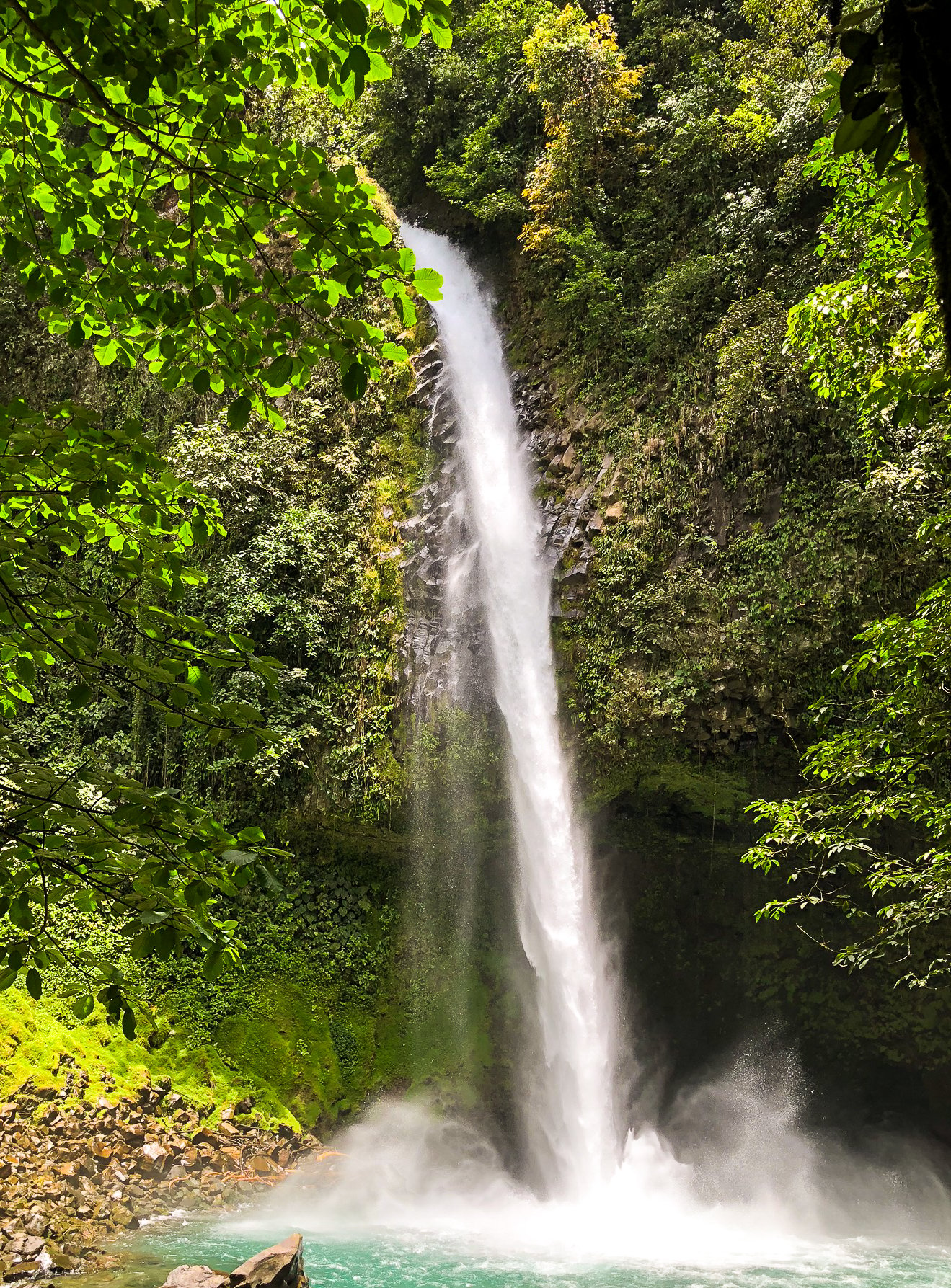Planning a trip to Costa Rica? Don’t miss these unforgettable experiences, from peaceful wildlife viewing to thrilling adventures and everything in beween.
Costa Rica is one of the most biodiverse countries in the world, with tons of adventurous activities and a warm, vibrant culture that savors the simple joys of life. This guide includes some of favorite overall things to do in Costa Rica sorted by type of experience. For an overview of activity highlights by geogrraphical regions of the country, check out this guide.
Scenery and Adrenaline
1. Explore Arenal Volcano
Costa Rica has six active volcanoes, the most famous of which is Arenal. Its dramatic conical shape and active eruptions up until 2010 helped to make it Costa Rica’s most renowned volcano. The nearby town of La Fortuna has flourished into a hub for tourism for the area. With a number of luxury spa resorts, small budget inns, and everything in between, there is no shortage of options of where to stay in La Fortuna.
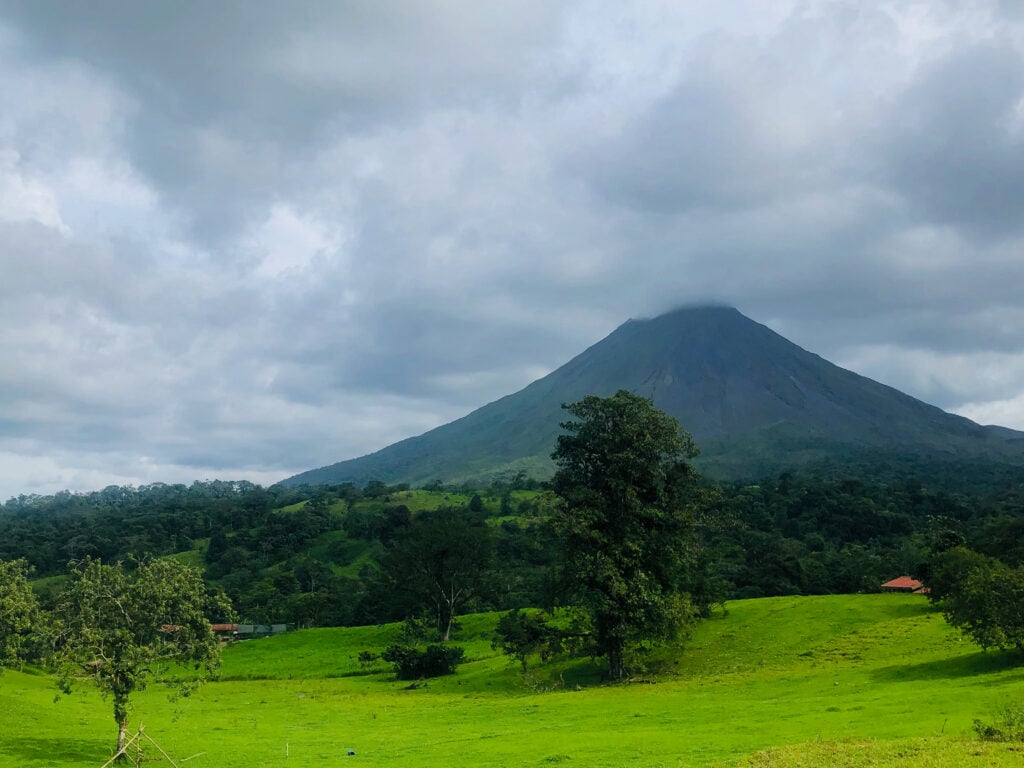
For your first trip to Costa Rica, I think Arenal is an unmissable part of the country. Don’t be put off by its high popularity with tourists; we have never felt overcrowded in the area, as the jungle is carefully protected from overtourism. From your base in La Fortuna, you can hike or mountain bike through Arenal Volcano National Park and go whitewater rafting on the Sarapiqui and Balsa Rivers during the day, then relax at a hot springs in the evening.
Tip: We've seen online forums commenting on the high prices around La Fortuna, but like most places popular with tourists, there's a range of accomodations and experiences for every budget. La Fortuna has many high end spa resorts that cater to a luxury-seeking crowd, but it can definitely be done on an affordable budget as well.
2. Zipline Through the Monteverde Cloud Forest
Monteverde Cloud Forest is a biological reserve with some of the longest ziplines in the country. There are a number of zipline tour operators in the area to choose from, but we recommend heading to Selvatura Park, which offers a tour of 13 ziplines including a 1 km Superman-style line for extra adrenaline with amazing views. Our guides were great; they make the experience all the more fun while ensuring everyone stays safe. While kids as young as 4 years old can technically zipline, there is some moderate hiking involved, so I would not recommend bringing younger kids unless they’re really used to this kind of physical activity.
3. Surf at Tamarindo or Nosara in Guanacaste
Costa Rica’s Pacific Coast in the Guanacaste province is known for its surfing. In Tamarindo, you’ll find surf schools on every corner and a fun nightlife scene. It’s one of the best places for beginners to learn. Nosara, by contrast, feels more laid-back, with surf culture blending into yoga retreats and wellness centers.
4. Hike Waterfalls
Costa Rica is overflowing with waterfalls, and some are easy to reach while others require an adventurous hike. Here are just a few of our favorites:
La Fortuna: A tall waterfall secluded in a grove-like clearing near Arenal Volcano. The hike to get here is short, but followed by a steep staircase leading to a pool where you can swim beneath the falls.
Nauyaca: Near Dominical, these twin cascades are stunning and massive. The hike is around 2.5 miles each way and moderate difficulty, with a large pool appropriate for swimming to cool off after.
Llanos de Cortés: Impressive, wide, and cascading. These falls are close to Liberia airport, making it perfect as a first or last stop on your trip. The hike is short but steep, and swimming is allowed.
El Tigre: More challenging to reach, around 5 miles total, with stunning scenery and a number of waterfalls along the way. Swimming is permitted.
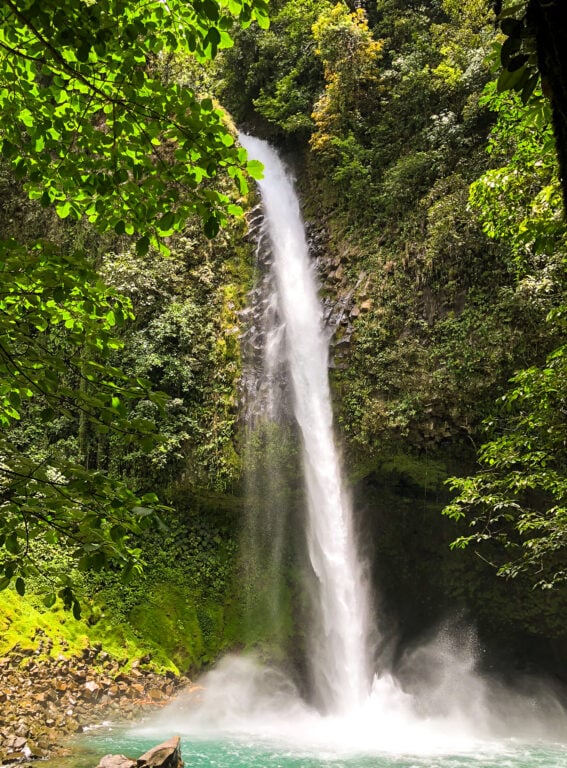
5. Go White-Water Rafting on the Pacuare River
The Pacuare River is considered one of the best in the world for white-water rafting with class III and IV rapids. The scenery is as stunning as the rapids are thrilling, with waterfalls cascading into the river and rainforest towering around the river. You may even spot toucans flying overhead. Since this is on the Caribbean side of the country, I recommend combining Pacurare river-rafting with a trip to Tortugero National Park a couple of hours away.
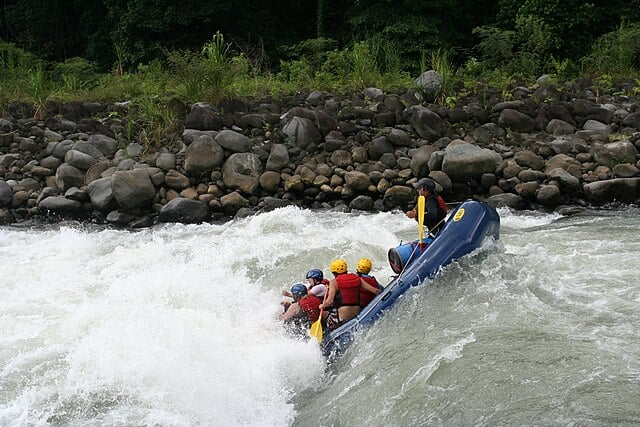
One, two, and three-day tours are offered here. I would opt for a two-day tour of your itinerary allows, with an overnight stay at Pacuare River Lodge directly on the river. They offer simple rooms for as little as $50 per night and coordinate your rafting or Torteugero tour.

Wildlife Encounters
6. Spot Wildlife in Manuel Antonio National Park
For wildlife viewing not too far from an international airport, go to Manuel Antonio. This small but popular national park blends jungle trails with white-sand beaches, and you’re likely to spot howler monkeys, capuchins, sloths, iguanas, and toucans.
The trade off with Manuel Antonio given its ease of access and popularity is that it gets busy, especially during the peak season. With its variety of other activities (snorkeling, ziplining, etc) as a developed tourist area, it’s a great pick for families, or if your itinerary is more compact and you don't want to spend too much time on the road. But if you prefer a more untouched jungle experience, we'd recommend a trip to Corcovado National Park.
7. Hike in Corcovado National Park, Osa Peninsula
Corcovado is often called the most biodiverse place on Earth, and unlike any other nature preserve we’ve visited. As it’s more remote than other parts of Costa Rica, Corcovado is less developed, more authentic-feeling, and with a high density of wildlife. Getting there takes effort and planning, but it’s well worth it.
You can join a tour from the towns of Drake Bay or Puerto Jimenez. Corcovado takes 6-7 hours to drive from SJO, so while you can certainly make the drive in one day, I suggest stopping for a night in the beach town Uvita before continuing further south.
8. Go Whale Watching in Uvita
Marino Ballena National Park is one of the best places in the world to see humpback whales, which migraine through the area twice a year (January to March and July to October). We took a boat tour and saw whales breaching right in front of us, along with dolphins riding the bow waves. Uvita itself is laid-back, with a beach shaped like a whale’s tail that you can walk out on during low tide.
9. Visit Tortuguero During Turtle Nesting Season
Located on the Caribbean Coast, Tortuguero National Park, as the name suggests, is most notable for its variety of turtle species that nest here. Laying seasons are March-May and July-October. Given the dedication to protecting the animals and their habitat, you’ll need a guide to visit the beach at night when the turtles come ashore to lay their eggs.
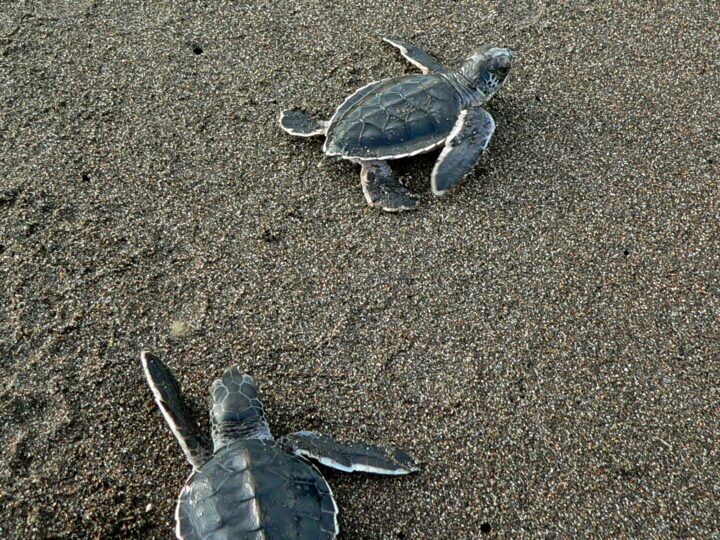
There is plenty to do in Tortuguero aside from just seeing the turtles, though. The park consists of a network of jungle canals that you can take a boat tour or kayak through, for an entirely different view of the jungle from anywhere else in Costa Rica.
Tip: Tortuguero is only accessible by boat or small plane. You can take the local airline Sansa from San Jose, or take a boat from La Pavona, Moin, and Cano Blanco.
10. Go on a Jungle Night Walk
The jungle is an entirely different organism at night, so try to schedule at least one guided night walk during your trip. On a night tour in La Fortuna, we spotted red-eyed tree frogs, snakes, and glowing insects. Whichever part of the country you’re staying in, there’s likely to be a night walk option available that you can find online or through your hotel. Since sunset is pretty early in Costa Rica, this is something kids can participate in without disrupting bedtime too much.
Culture & Local Flavor
11. Take a Coffee & Chocolate Tour in the Central Valley
Costa Rica’s coffee is world-famous, and seeing the process from bean to cup gave us a whole new appreciation for our morning brew. On a coffee and chocolate tour, you’ll walk through plantations, taste cacao straight from the pod, and sip fresh-roasted coffee.
The Central Valley (around San José) is the heart of Costa Rica’s coffee production, so it’s an easy half-day trip.
12. Experience Local Culture in San José
Most travelers skip San José, but we enjoyed spending a day here. The National Theatre is stunning, the Central Market buzzes with life, and the Gold Museum gives a glimpse into Costa Rica’s pre-Columbian history. San José is also a great base for day trips, like visiting the Poás Volcano or touring nearby coffee farms.
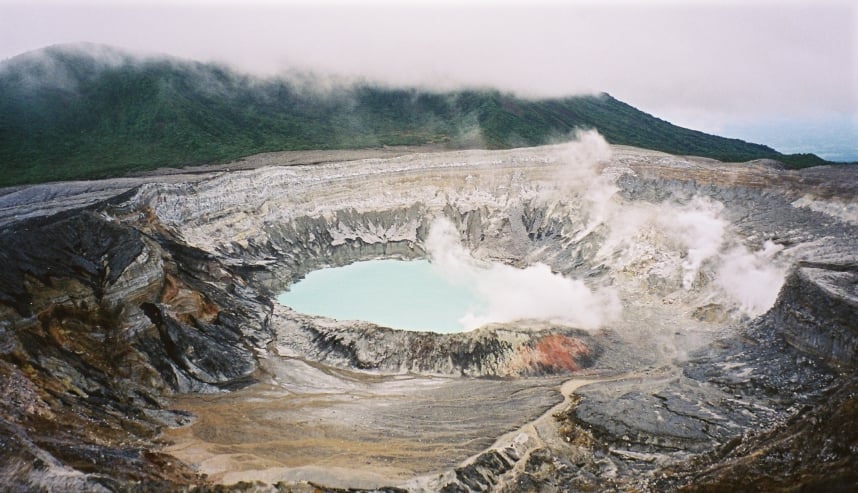
13. Take a Local Cooking Class
Learning how to make a local dish is one of our favorite ways to experience a new country while chatting with a local chef to learn more about the culture. It's a souvenir we can bring home without taking up any space.
14. Enjoy the “Pura Vida” Lifestyle
More than an activity, pura vida is a mindset. It means “pure life,” and you’ll hear it everywhere in Costa Rica. The saying embodies a sense of positivity, simplicity, and an appreciation for life. You’ll see “pura vida” all over Costa Rican souvenirs, but when we talked with the locals, we could see that it’s not just a slogan for tourists, but that it really is a mindset and approach to life.
Final Thoughts
Costa Rica has so much to offer: volcanoes and beaches, adventure and relaxation, jungle hikes and cultural immersion. That’s what makes it such an incredible destination—you can combine a number of experiences in a single trip.
Whether you’re planning your first visit or coming back for more, these adventures are a perfect starting point. Mix and match a few regions to build your itinerary, and you’ll quickly see why Costa Rica is one of our favorite places on Earth.
FAQs
When is the best time to visit Costa Rica?
The dry season (December–April) offers the most sunshine, especially on the Pacific Coast. The green season (May–November) means fewer crowds, lush landscapes, and better prices. We’ve visited during both and honestly enjoyed the green season just as much.
Is Costa Rica safe for travelers?
Yes, Costa Rica is considered one of the safest countries in Central America. We felt very comfortable traveling with kids. Like anywhere, use common sense: keep an eye on your belongings, avoid isolated beaches at night, and don’t leave valuables in your rental car.
How many days do you need in Costa Rica?
If it’s your first trip, we recommend at least 7–10 days. That gives you time to visit two-three different regions—like a beach town and a jungle area—without spending too much time in transit. With less time, stick to one base to really soak it in.
Do you need a car in Costa Rica?
A rental car gives you the most freedom, especially if you want to explore off-the-beaten-path waterfalls or small towns. But for major tourist routes, you can get by with shuttle buses and tours. We’ve done both, depending on the trip.
Can you drink the water in Costa Rica?
Yes, tap water is safe to drink in most places. We carried reusable bottles everywhere and rarely had to buy bottled water.
